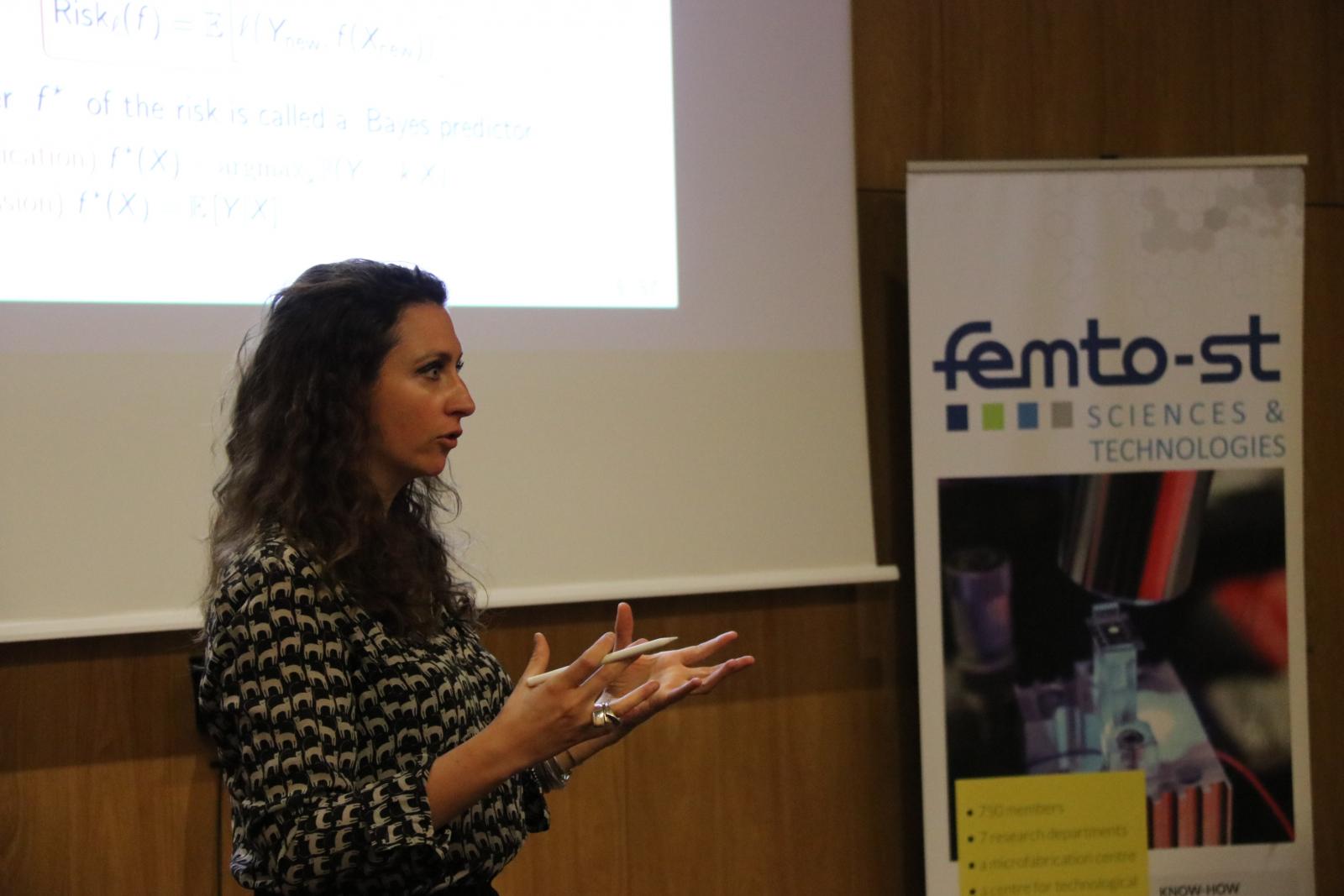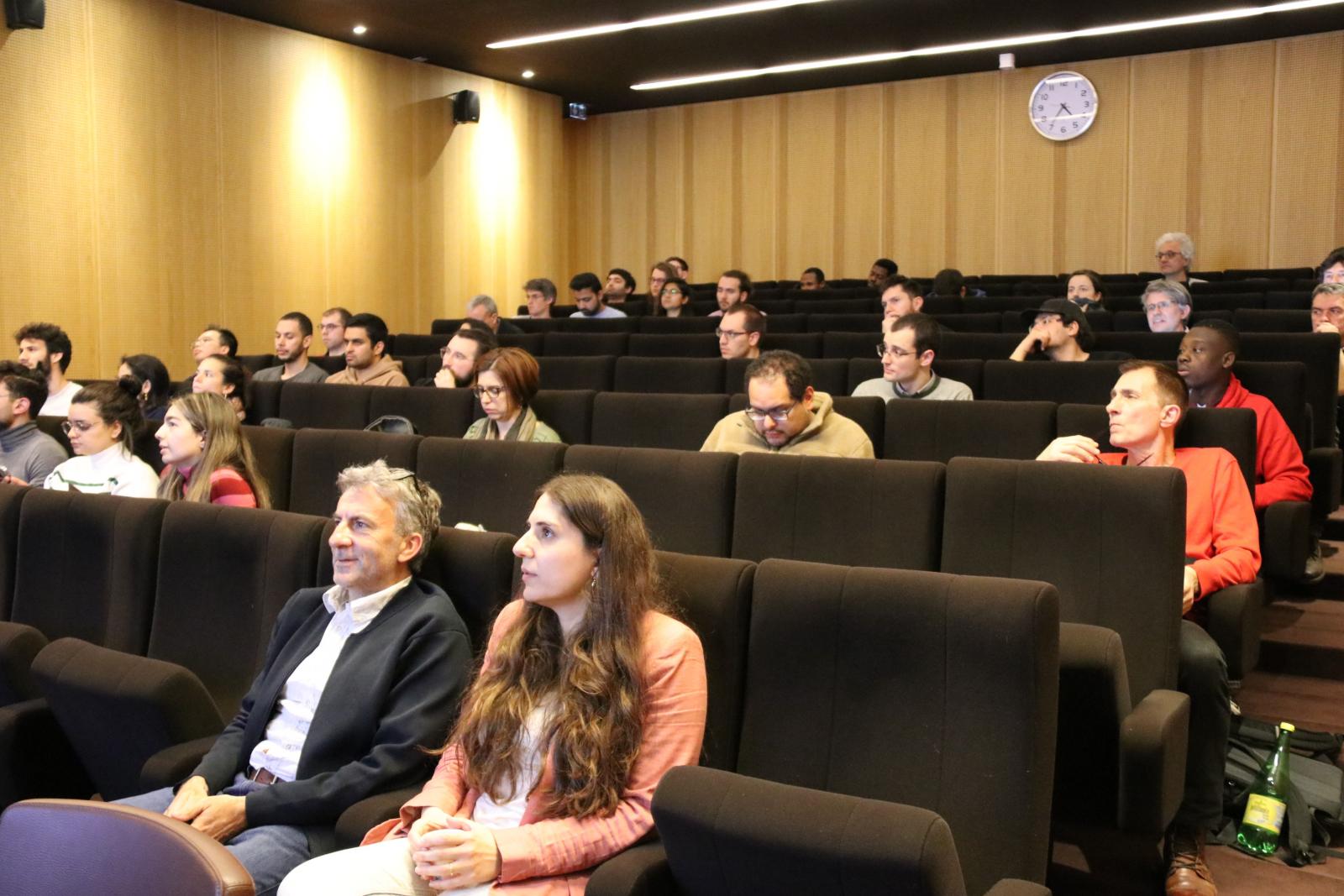Leçons II
Deux demi-journées de cours sont programmées mercredi 29 novembre 2023 après-midi et jeudi 30 novembre matin. Le but de ces Journées est d’aborder quelques questions liées à la théorie du contrôle.
Elles s'insèrent dans le cadre des leçons de mathématiques.
Il est prévu 3 cours.
- Orbits of linearly controlled systems and approximations by group structures, par Enrico Le Donne (Université de Fribourg, Suisse)
- SubRiemannian geodesics and magnetic fields, par Nicola Paddeu (Université de Fribourg, Suisse)
- Introduction à la mesure continue en mécanique quantique, par Antoine Tilloy (CAS Mines Paris - PSL)
Ces journées sont organisées avec le LMB. Ci-dessous un lien Evento pour l'inscription :
https://evento.renater.fr/survey/maspin-journees-masp...-p4j8lydg
Ces demi-journées se tiendront amphi Jules Haag à l'ENSMM.
Programme
Mercredi 29 novembre
14h00-15h00. Enrico Le Donne - lecture 1
15h00-15h20. Pause café
15h20-16h20. Enrico Le Donne - lecture 2
16h20-16h40. Pause et questions
16h40-17h40. Nicolas Paddeu
17h40-18. Discussions
Jeudi 30 novembre
9h-10h30. Antoine Tilloy - lecture 1
10h30-10h50. Pause café
10h50-12h20. Antoine Tilloy - lecture 2
Résumés
Orbits of linearly controlled systems and approximations by group structures, par Enrico Le Donne
Abstract. We discuss some differential systems that depend on linear variables. We mostly focus on the one-wheel robot and on the system of the bike. Possibly, we generalize the discussion to tracks with trailers. The aim is to understand the dynamics and mechanics of such systems, and to prove that they are completely controllable, in the sense that for every two configurations of the robot there exist strategies to steer/control the robot from one configuration to the other configuration. These systems are modelled as linearly controlled systems. In a second part of the talk, we shall discuss how to approximate such systems with systems that in addition admit group structures and dilations. The benefit is an estimation of the control distance for small variations. The mathematical methods that are discussed are: complex numbers, vector fields seen as derivations, Lie brackets, metric spaces, Lie groups.
SubRiemannian geodesics and magnetic fields, by Nicola Paddeu
Abstract. We study optimal trajectories for linear control systems. We focus on normal geodesics: optimal trajectories that solve Hamiltonian type equations. The key idea is to associate to every magnetic field a linear control system, in such a way that the trajectories of charged particles inside the magnetic field correspond to normal geodesics for the linear control system. Using this correspondence, we prove the existence of non-normal optimal trajectories and we construct a linear control system for which branching of normal geodesics occurs.
Introduction to continuous measurement in quantum mechanics, by Antoine Tilloy
Abstract. In quantum mechanics, there are in principle two types of dynamics: unitary evolution and measurement, to be used in different situations. The latter, measurement, is peculiar in that it seems that it cannot be done continuously, because of the Zeno effect freezing the evolution of the quantum state. However, one can work in a proper limit of infinitely frequent but infinitely weak measurement, where interesting continuous stochastic dynamics (Ito stochastic processes in Hilbert space) emerge, without Zeno effect. This formalism of quantum trajectories was discovered in the nineties, but there has been a continuous improvement since. Initially a theoretical curiosity, those continuous measurement trajectories are now crucial to describe real physical systems, like superconducting circuits. I will explain how the formalism can be derived from ordinary quantum mechanics, discuss some examples, and then finally present more recent results regarding the numerical computation of solutions of the resulting stochastic differential equations.
=======================================================================
=======================================================================
Leçons I
Deux demi-journées de cours sur le machine learning et la quantification des incertitudes.
Ces demi-journées se tiendront le 24 après-midi et le 25 avril matin en amphi Gagnepain à Temis et seront assurées par
Claire Boyer (MCF, Sorbonne Université, https://perso.lpsm.paris/~cboyer/index.html)
Margaux Zaffran (Doctorante à INRIA https://mzaffran.github.io)
Stéphane chrétien (Professeur à Lyon 2, https://sites.google.com/site/stephanegchretien/home)
Remi Vaucher (Doctorant à Lyon 2)
Des collègues du Groupe Malia a participé au succès de l’événement.
Détail du cours :
Monday April 24th from 2pm to 6pm
Stéphane Chrétien and Rémi Vaucher
Title: Introduction to Machine Learning with Python
Abstract: Machine Learning is a new field at the intersection of Statistics, Mathematics and Computer Science, which aims to build new input-output functions in order to mimic human behaviour, augment its capabilities or simplify execute sequences of tedious tasks that humans are not able or do not want to perform by hand. One simple example of input-output function is linear regression and another less simple example is GPT4. The goal of the proposed lectures is to provide a down-to-earth introduction to the various methods of machine learning and how to implement them in Python as well as how to assess their performance. We will use the teaching material created by Sebastian Raschka which will provide a solid starting point for any one who wishes to explore this fast-growing field.
Tuesday April 25th from 8.30am to 12.30pm
Claire Boyer et Margaux Zaffran
Titre : Introduction to conformal prediction
Abstract: By leveraging increasingly large data sets, statistical algorithms and machine learning methods can be used to support high-stakes decision-making problems such as autonomous driving, energy, medical or civic applications, and more. In order to ensure the safe deployment of predictive models, it is crucial to quantify the uncertainty of the resulting predictions, communicating the limits of predictive performance. Therefore, uncertainty quantification attracts a lot of attention in recent years, particularly methods that are based on Conformal Prediction. Conformal Prediction provides controlled predictive regions for any underlying predictive algorithm (e.g., neural networks and random forests), in finite samples with no assumption on the data distribution except for the exchangeability of the train and test data. Conformal Prediction has already been successfully used to predict in real time the results of the last US presidential elections (2020) by the Washington Post.
This short course is a first introduction to Conformal Prediction, aimed at a broad audience of practitioners and researchers. It requires basic knowledge in statistics, probability and machine learning (including regression, classification, training and validation splitting strategies, for example, but no prior knowledge in any specific machine learning algorithms is required). We will implement the presented methods, and available software will be reviewed.




